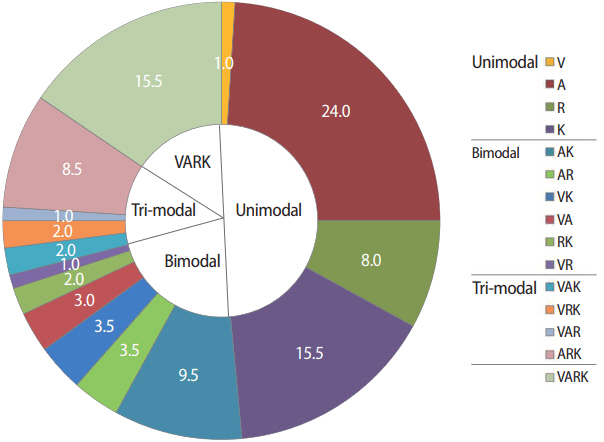J Educ Eval Health Prof.
2018;15:8. 10.3352/jeehp.2018.15.8.
Does learning style preferences influence academic performance among dental students in Isfahan, Iran?
- Affiliations
-
- 1Dental Research Center, Department of Pediatric Dentistry, School of Dentistry, Isfahan University of Medical Sciences, Isfahan, Iran.
- 2School of Medicine, Tehran University of Medical Science, Tehran, Iran. Narges.akhlaghi@gmail.com
- KMID: 2439264
- DOI: http://doi.org/10.3352/jeehp.2018.15.8
Abstract
- PURPOSE
The present study aimed to identify the learning preferences of dental students and to characterize their relationship with academic performance at a dental school in Isfahan, Iran.
METHODS
This cross-sectional descriptive study included 200 undergraduate dental students from October to November 2016. Data were collected using a 2-part questionnaire. The first part included demographic data, and the second part was a Persian-language version of the visual, aural, read/write, and kinesthetic questionnaire. Data analysis was conducted with the chi-square test, 1-way analysis of variance, and multiple linear regression.
RESULTS
The response rate was 86.6%. Approximately half of the students (51.5%) had multimodal learning preferences. Among the unimodal group (48.5%), the most common mode was aural (24.0%), followed by kinesthetic (15.5%), reading-writing (8.0%), and visual (1.0%). There was a significant association between academic performance and the reading/writing learning style preference (P<0.01).
CONCLUSION
Multimodal learning styles were the most preferred. Among single-mode learning styles, the aural style was most common, followed by the kinesthetic style. Students with a reading/writing preference had better academic performance. The results of this study provide useful information for preparing a more problem-based curriculum with active learning strategies.
MeSH Terms
Figure
Reference
-
References
1. Jiraporncharoen W, Angkurawaranon C, Chockjamsai M, Deesomchok A, Euathrongchit J. Learning styles and academic achievement among undergraduate medical students in Thailand. J Educ Eval Health Prof. 2015; 12:38. https://doi.org/10.3352/jeehp.2015.12.38.
Article2. Fleming N. VARK a guide to learning styles: frequently asked questions [Internet]. Christchurch: VARK Learn Limited;c2001-2013. [cited 2016 Aug 10]. Available from: http://www.vark-learn.com/english/page.asp.3. Sarabi-Asiabar A, Jafari M, Sadeghifar J, Tofighi S, Zaboli R, Peyman H, Salimi M, Shams L. The relationship between learning style preferences and gender, educational major and status in first year medical students: a survey study from iran. Iran Red Crescent Med J. 2014; 17:e18250. https://doi.org/10.5812/ircmj.18250.
Article4. Peyman H, Sadeghifar J, Khajavikhan J, Yasemi M, Rasool M, Yaghoubi YM, Nahal MM, Karim H. Using VARK approach for assessing preferred learning styles of first year medical sciences students: a survey from Iran. J Clin Diagn Res. 2014; 8:GC01–GC04. https://doi.org/10.7860/JCDR/2014/8089.4667.
Article5. Omar E. Perceptions of teaching methods for preclinical oral surgery: a comparison with learning styles. Open Dent J. 2017; 11:109–119. https://doi.org/10.2174/1874210601711010109.
Article6. Al-Saud LM. Learning style preferences of first-year dental students at King Saud University in Riyadh, Saudi Arabia: influence of gender and GPA. J Dent Educ. 2013; 77:1371–1378.
Article7. Shenoy N, Shenoy K A; U P R. The perceptual preferences in learning among dental students in clinical subjects. J Clin Diagn Res. 2013; 7:1683–1685. https://doi.org/10.7860/JCDR/2013/4940.3219.
Article8. Almigbal TH. Relationship between the learning style preferences of medical students and academic achievement. Saudi Med J. 2015; 36:349–355. https://doi.org/10.15537/smj.2015.3.10320.
Article9. Liew SC, Sidhu J, Barua A. The relationship between learning preferences (styles and approaches) and learning outcomes among pre-clinical undergraduate medical students. BMC Med Educ. 2015; 15:44. https://doi.org/10.1186/s12909-015-0327-0.
Article10. Saber A, Tabatabaei SM, Akasheh G, Sehat M, Zanjani Z, Larijani B. Face and content validity of the MacArthur competence assessment tool for the treatment of Iranian patients. Int J Prev Med. 2017; 8:75. https://doi.org/10.4103/ijpvm.IJPVM_367_16.
Article11. Gadbury-Amyot CC, Redford GJ, Bohaty BS. Dental students’ study habits in flipped/blended classrooms and their association with active learning practices. J Dent Educ. 2017; 81:1430–1435. https://doi.org/10.21815/JDE.017.103.
Article12. Urval RP, Kamath A, Ullal S, Shenoy AK, Shenoy N, Udupa LA. Assessment of learning styles of undergraduate medical students using the VARK questionnaire and the influence of sex and academic performance. Adv Physiol Educ. 2014; 38:216–220. https://doi.org/10.1152/advan.00024.2014.
Article13. Bennadi D, Kashinath KR, Bharateesh JV, Kshetrimayum N. Assessing learning preferences of dental students using visual, auditory, reading-writing, and kinesthetic questionnaire. J Indian Assoc Public Health Dent. 2015; 13:163–168. https://doi.org/10.4103/2319-5932.159055.
Article14. AlQahtani N, AlMoammar K, Taher S, AlBarakati S, AlKofide E. Learning preferences among dental students using the VARK questionnaire: a comparison between different academic levels and gender. J Pak Med Assoc. 2018; 68:59–64.15. Asiry MA. Learning styles of dental students. Saudi J Dent Res. 2016; 7:13–17. https://doi.org/10.1016/j.sjdr.2015.02.002.
Article
- Full Text Links
- Actions
-
Cited
- CITED
-
- Close
- Share
- Similar articles
-
- Learning style preferences of nursing students at two universities in Iran and Malaysia
- Participation and Academic Achievement by Learning Styles in Problem Based Learning
- Level of knowledge of dental practitioners in Isfahan, Iran about cone-beam computed tomography and digital radiography
- The Assessment of Medical Students' Learning Styles using the Kolb Learning Style Inventory
- Presentation of Cerebral Autosomal Dominant Arteriopathy With Subcortical Infarcts and Leukoencephalopathy (CADASIL) in the Acute Phase of COVID-19 Infection


